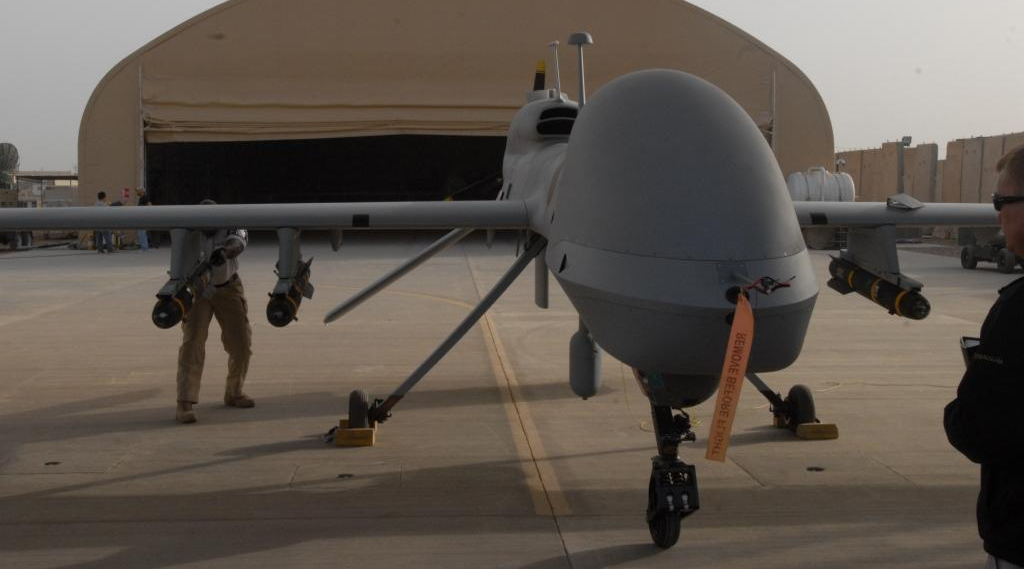Air Defense and the Limits of Drone Technology
The hype about medium-altitude long-endurance drones pays too little attention to their vulnerability.

Published by The Lawfare Institute
in Cooperation With

Editor’s Note: Drones are often heralded as revolutionizing warfare, but recent experiences in Ukraine and elsewhere suggest that these systems have many vulnerabilities. Drawing on their longer research, Antonio Calcara, Andrea Gilli, Mauro Gilli, and Ivan Zaccagnini argue that drones are highly vulnerable to air defenses and that highly-trained humans are vital for drones to be their most effective.
Daniel Byman
***
After two decades of hype, the war in Ukraine is prompting a reevaluation of the utility of military drones. Ukrainian forces used Turkish Bayraktar TB2 drones to great effect in the early days of the conflict, and the United States has discussed selling Ukraine MQ-1C Gray Eagles. But as the war has progressed, these platforms have become less effective. According to a Ukrainian air force pilot interviewed by Foreign Policy magazine, Turkish TB2s “were very useful and important in the very first days [of the war], stopping those columns [of armored vehicles], but now that [the Russians have] built up good air defenses, they’re almost useless.” Another Ukrainian air force pilot echoed this sentiment, telling Breaking Defense, “[I]t’s very dangerous to use such expensive drones [like the Gray Eagle], in our case, because of [the] enemy’s air defense …. It’s not Afghanistan here.” Along the same lines, military analysts writing for The Drive note that U.S. defense planners have a similar assessment. “[T]he U.S. Army has reached many of the same conclusions about the [Gray Eagle]’s ability to survive even in environments with relatively limited threats,” they write. “The U.S. Air Force has been looking to move away from the MQ-9 Reaper, the Gray Eagle’s larger cousin, for the same reasons.”
These assessments contradict the dominant narrative that military drones are a war-winning weapons system. Early on during the Russian invasion of Ukraine, for instance, some observers cheered Turkish drones as a decisive weapon, so much so that there have been popular fundraising initiatives to purchase more TB2s for Ukraine. Similar narratives emerged during the 2020 Nagorno-Karabakh war between Armenia and Azerbaijan and during the battle for western Libya in 2019, when some analysis described armed drones as a “magic bullet” or “game changer.” In light of these understandings, the New Yorker went so far as to claim that the TB2 “changed the nature of warfare.”
In two recent articles, one published in International Security and one forthcoming in Security Studies, we make sense of these divergent perspectives by focusing on the dynamic interaction between military drones trying to penetrate enemy airspace and air defense systems trying to protect it. Whereas the debate on drones largely ignores the role of air defense, we argue that since the 1960s, improvements in electronics, materials, and propulsion have dramatically enhanced the capacity of air defenses to detect, track, engage, and destroy aerial targets. As a result, air defenses represent a formidable threat for any aircraft—as the U.S. experience in Vietnam and in Yugoslavia shows. In one of our scholarly articles, we looked at the Libyan civil war, the Syrian civil war, and the Nagorno-Karabakh war. Our empirical analysis shows that modern air defenses represent a particularly serious threat for medium-altitude long-endurance (MALE) military drones, which has to do with the physics of electromagnetic backscattering, how integrated air defense systems operate, and modern signal processing.
MALE drones can penetrate enemy air space defended by some types of air defenses but are not effective against modern integrated air defense systems that feature ground-based and airborne radars and engagement systems. They pose no significant challenge for modern radars: The reported radar echo of most MALE drones makes them detectable and trackable at long range. Russian early-warning radars can detect an aerial vehicle like a MALE drone up to 126 miles away, and a fire-control radar can detect and track it from as far away as 69 miles.
Additionally, tactics aimed at reducing the available time for enemy air defenses to react are effective against only some nodes of an integrated air defense system. For instance, an air force that wants to penetrate enemy air space to strike ground targets with armed drones can employ specific tactics—such as flying at low altitude to postpone detection by enemy radars—but this tactic is effective only against ground-based systems, not against airborne ones. As the elevation of a radar increases, so does the range at which it can detect aircraft flying at low altitude; air defense systems can still manage to detect low-flying aircraft at range by deploying radar on top of mountains or tall masts, or by relying on aerial assets like airborne early warning and control aircraft or patrolling jet fighters.
The capabilities of modern air defenses do not mean that MALE drones will always be detected—detection is a probability game. However, against state-of-the-art air defense systems, MALE drones by themselves are unlikely to be systematically, consistently successful, because different types of ground-based and airborne systems will be in position to detect, identify, track, and engage incoming drones. Russia’s air defenses combine these capabilities to make penetrating Russian airspace difficult. As one of the Ukrainian air force pilots told Breaking Defense, “My opinion is knowing the Russian air defense right now, and knowing that range of the missiles that Gray Eagle, I’ll give you a 90% chance that it will be shot down.”
Since the development of modern air defense systems in the 1960s, air warfare has been dominated by a “hider-finder” competition between air defense and air penetration. This hider-finder competition penalizes those that fail to master the set of tactics, techniques, procedures, technologies, and capabilities needed to avoid enemy detection, while enemy targets that are detectable suffer heavy costs. The more capable the air defense, the more difficult the air penetration; the more capable the air penetration, the more difficult the air defense.
For air penetration, the hider-finder competition entails avoiding, degrading, and/or destroying enemy air defenses. Because drones can be detected, tracked, and engaged by radar systems, employing them against a country with modern, integrated air defense systems would require extensive infrastructure and operational support. First, a country might use cyberattacks to degrade the enemy air defense network. Second, intelligence, surveillance, and reconnaissance capabilities would need to detect and transmit the position of ground-based air defenses to mission planners in real time so that they could identify possible routes that exploit gaps in radar coverage and minimize the probability of detection. Third, supporting forces would need to deploy decoys to deceive enemy air defense systems into revealing their positions so that suppression assets could then target them with anti-radiation missiles and loitering munitions. Any aircraft flying in to attack these air defenses or subsequent targets would have to be supported by electronic warfare assets that could blind or deceive any still-active enemy radars.
Whether or not the hider-finder competition is difficult for countries employing MALE drones depends on the capabilities of the enemy air defenses. If the enemy possesses limited air defense systems, employing MALE drones over enemy territory poses relatively limited risks, even though it still requires extensive infrastructural and organizational support in terms of communications, control centers, intelligence, surveillance, target acquisition, and more. This is why during the global war on terror, the United States employed MALE drones extensively for counterinsurgency operations. But even in these environments with relatively weak air defenses, MALE drones have become increasingly vulnerable in recent years, as access to surface-to-air missiles have increased for rebels and insurgents.
Against more capable enemy air defenses, the hider-finder competition becomes much more demanding and unforgiving. Over the past 20 years, improvements in data collection (sensor acuity and multi-sensor connectivity), data storage (big data), and data analytics (for example, machine learning) have significantly enhanced air defense systems’ capability for detection, tracking, and identification. Moreover, state-of-the-art air defense systems now possess advanced cyber defenses and electronic counter-countermeasures to avoid being detected, jammed, or suppressed. These capabilities further complicate the tasks for air penetration.
The vulnerability of drones was particularly evident in Libya, where Turkey took advantage of a cease-fire in January 2020 to deploy air defense systems that helped down Chinese-made MALE drones, deterring their further use. When MALE drones have been successful in recent conflicts, it was because they were employed in conjunction with other assets and platforms, such as electronic warfare that blinded and deceived enemy radars, decoys that deceived enemy radars, artillery that used reconnaissance data from drones to strike enemy positions, or special forces that provided targeting information.
In practical terms, drones have not led to an era of air-offense dominance. Instead, MALE drones remain vulnerable to state-of-the-art air defense systems. As a result, because of the supporting assets and capabilities required to employ military drones effectively in conventional conflicts, drones have not been an equalizer in world politics. They have extended existing power imbalances, rather than canceling them. Despite popular beliefs that drones are a war-winning weapon and that countries can wage war without deploying troops on the ground, proficient military personnel have been a critical element in recent conflicts.
Some commentators have argued that because of their much cheaper cost, drones are expendable—a feature that provides an offensive advantage and would empower weaker actors. There is some truth to this, but the argument needs to be qualified. To start, even expendable drones must be sophisticated enough to be effective in contested airspace, but the technologies that would make them effective are investments that raise their cost and make them less expendable. Moreover, there are many relatively inexpensive solutions that can ground incoming enemy’s drones, including man-portable air-defense systems, anti-air guns, and electronic warfare systems, among others. Finally, some observers argue that in the future drone swarms will represent a formidable threat for air defenses. This might very well be true, but only if the swarm technology can overwhelm new developments on the other side of the equation: concomitant advances in air defenses. The very same technologies believed to strengthen the offense, such as artificial intelligence and big data, are also strengthening the defense. Whether swarm tactics in the future will be able to defeat air defenses should be investigated, not assumed.
Our articles bring attention to the interactions between attacking and defending forces in an age of high technology. In doing so, we adapt the innovation and counter-innovation dynamics that have played a key role across history to the exigencies of the era of precision. In the past, the innovation and counter-innovation dynamic led to the development of more resistant defenses—shields, fortress walls, and armor—and more powerful weapons—from bows to cannon balls. In a time of precise and destructive munitions, the competition is about finding the enemy while hiding from their defenses. The principles of hider-finder competition have been applied to trends in submarine warfare and cyber warfare, and also promise to help illuminate other realms. These competitive dynamics demonstrate the need to bring the role of air defenses back into the discussion of drone warfare, when many analyses of drones and other new aviation technologies have paid them insufficient attention. As Kenneth Werrell, a historian of air defense systems, has put it, “Readers are more interested in the aircraft than the weapons that bring them down.” Yet the role of air defenses since World War II cannot be overstated. As a Ukrainian air force pilot told Breaking Defense, “I’d say that the ground-based air defense was the key in this war, and it’s still the key [moving forward].”
The opinions expressed in this article do not represent those of NATO, NATO Defense College, or any other organization with which the authors are or have been affiliated.








